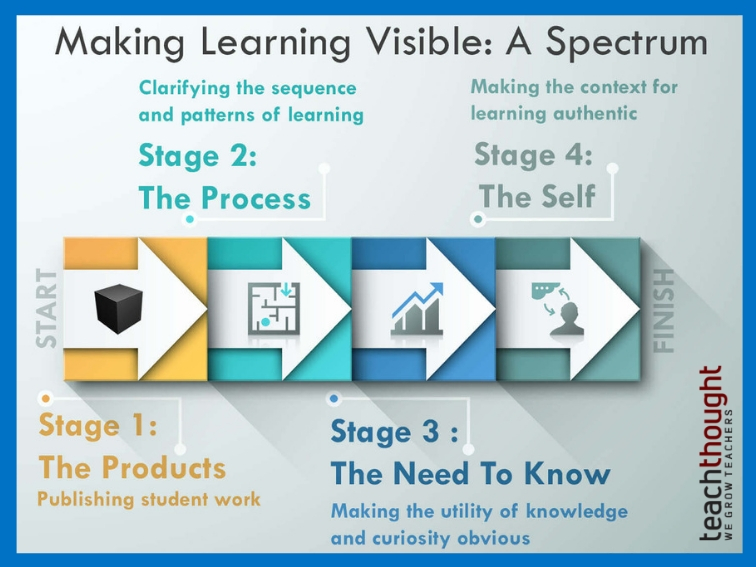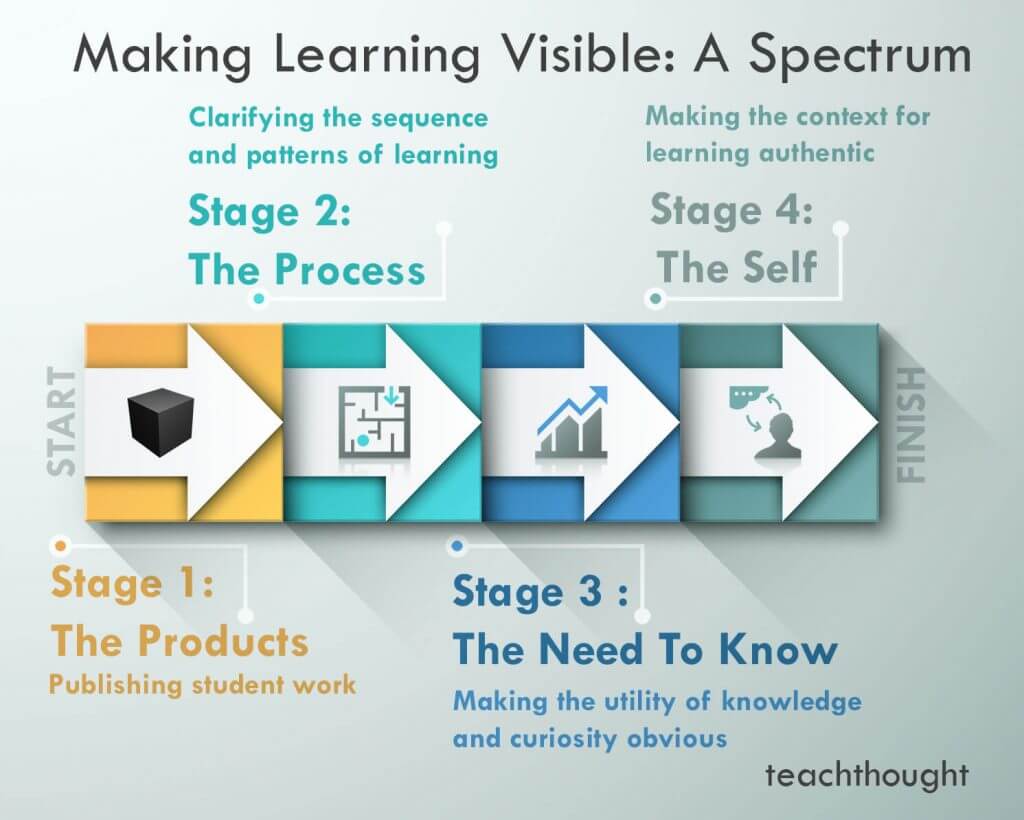
A Spectrum Of How To Make Learning Visible
What students say and do and create are products of thought processes that, more or less, are predictable–and of significant potential if we can make those processes visible.
The idea of making learning visible isn’t new. This is an idea as old as conversation or writing–show me what you know. It comes in many forms, from essays, quizzes, and exams, to the lifeless “What’d you learn in school today?” conversation after school.
Playing an automotive racing video game recently, I unlocked a badge for accruing a certain number of miles on a specific track. As I was driving–or rather, pushing buttons on a controller that simulated a lot of the visuals and some of the sensations of racing a car–a little badge popped up at the bottom of the screen, along with a title reflecting what I’d accomplished. Learning badges and trophies are usually seen as a reward for an accomplishment, but they’re not very good at it. They flash on the screen, create an all-too-brief dopamine response, and are gone.
On modern video game platforms like The Xbox One, PlayStation 4, and Steam, no one really cares about these collections because everyone has them. They might be quantified, as in “I have more points or trophies than you,” but as individual episodes of achievement, they’re mostly anonymous, which means they fail to signify something actually worth signifying.
In a learning ecology–as we use them now–digital badges usually cause little excitement and mean nothing. As levers of gamification, however, they have the potential to uncover the nuance of performance, as I explained in that post.
“A digital trophy system–if well-designed–offers the ability to make transparent not just success and failure, accolades and demerits, but every single step in the learning process that the gamification designer chooses to highlight. Every due date missed, peer collaborated with, sentence revised, story revisited, every step of the scientific process and long-division, every original analogy, tightly-designed thesis statement, or exploration of push-pull factors–every single time these ideas and more can be highlighted for the purposes of assessment, accountability, and student self-awareness.”
So, in the best of cases, these icons can be gathered into a personal collection to act as an uber-report card. Imagine the icons on your phone or tablet as symbols of something important attempted or accomplished by a student. That’d be a great starting point for learning badge and gamification “2.0,” but merely updating a broken system doesn’t seem like the best use of our time. It’s much more fun to speculate what might be possible if we’re willing to squint a little to maybe find something we haven’t found before.
Transfer
The shift from proving understanding of externally-driven content (i.e., curriculum maps and pacing guides created from a universal set of standards) to turning inward and learning to ask questions that sustain learning isn’t simply a matter of process, but purpose and human outcome. See John Dewey explain.
“From the standpoint of the child (Ed note: this is the only standpoint that matters, right?), the great waste in the school comes from his inability to utilize the experiences he gets outside the school in any complete and free way within the school itself; while, on the other hand, he is unable to apply in daily life what he is learning at school. That is the isolation of the school — its isolation from life. When the child gets into the schoolroom he has to put out of his mind a large part of the ideas, interests, and activities that predominate in his home and neighborhood. So the school, being unable to utilize this everyday experience, sets painfully to work, on another tack and by a variety of means, to arouse in the child an interest in school studies. While I was visiting in the city of Moline a few years ago, the superintendent told me that they found many children every year, who were surprised to learn that the Mississippi river in the textbook had anything to do with the stream of water flowing past their homes.” (Dewey 1916)
In focusing on narrow data from a fixed curriculum using universal assessments, it might be that we’ve gotten the learning process itself all knotted up. Curiously, there haven’t been very many attempts to make learning, in and of itself, visible. Letter grades and paper certificates make up the bulk of these efforts, and digital portfolios and project-based learning artifacts are about as exotic as it gets.
Badges are a more recent entry into this field, but we’re falling far short of what’s possible. In short, badges as evidence of achievement are interesting, but insufficient because they are residual. Leftover. Effects. Artifacts. Fin. But if we use them as simply the first “stage” of a growing idea, then we can both illuminate and catalyze learning as a process while it’s happening–and in the process, connect students with someone other than the teacher.
The question becomes then, what should we make visible, how, and to whom?
How To Make Learning Visible: A Spectrum
Below is a kind of model to think about this. It is set up here as a spectrum. Stage 1 represents early thinking about the idea–essentially, where many classrooms are today, while Stage 4 represents more developed thinking–what “classrooms” might seek to become as we move beyond “I’m done with this assignment” thinking.

The big idea, then, is to evolve the thinking behind letter grades, certificates, and badges in pursuit of a genuine ecology of learning–pushing past simply sharing evidence of “mastery” (which is perishable), toward a focus on the students as they ask questions, seek information, apply their own thinking, and see learning as a fluid–and entirely personal–process.
Big Idea: A shift from emphasizing the products of learning to the process of learning
Stage 1: Product (The Artifacts Of Learning)
At the first stage of this “spectrum” of making learning visible, there is emphasis on the finished products students create. This can provide evidence of understanding, and allows other stakeholders in education an opportunity to infer what’s happening in the classroom. This is also where most classrooms are today.
Examples:
Physical projects and models, essays, posters, blog posts, badges of completion, ribbons, letter grades, diplomas, certificates, PowerPoints, project-based learning artifacts, photographs
Driving Question(s):
What compelling evidence of performance and understanding can be shared with others? What is the most authentic way to publish student work in affectionate and attentive communities?
Stage 2: Process (The Patterns & Sequence Of Learning)
As we make learning visible during this second stage, the process and sequence of learning is illuminated. This may include ongoing or even finished projects shared, but only insofar as student habits, decisions, developing understanding, and ongoing performance are concerned. This helps students see understanding as alive–and thus capable of growth or decay–and always evolving.
This also helps schools and teachers see student performance as an extraordinarily individual and often chaotic–even Rhizomatic–journey, and design curriculum, assessment, learning feedback, and other systems around that idea.
Examples:
Any practices that encourage metacognition, journaling about the Habits of Mind, making room for failure, revisiting old work for reflection or improvement, entrepreneurship projects (including community projects and businesses), visual data that shows change over time, returning to “places” (physical or digital) of learning, the iteration of digital portfolios (rather than the artifacts themselves), reflecting on what students felt emotionally during the process of learning
Driving Question(s):
What does “personalized learning” mean? How do students learn differently–both in a standardized curriculum, and in a model where each student learns something different? How can the nature of learning as a process be made visible–and in a way that serves the student as much as those around them?
Stage 3 : Need To Know (The Reason For Learning)
At this advanced stage of making learning visible, knowledge demands and curiosity are the focus. Here, what students need to know is supplemented–and empowered–by why they need to know it. These two concepts work together to bolster both curiosity and the utility of knowledge.
Driving Question(s):
How can the need to know be communicated, emphasized, and published? What role does curiosity play? What is the difference between “engaged academic” and “authentic learning”?
Examples:
Informal learning, demonstrated curiosity, problem-based learning, challenge-based learning, visible transfer of knowledge, communal constructivism, self-directed learning as a classroom model
Stage 4: The Self (The Context For Learning)
The last of these so-called “stages” of making learning visible finishes with the student themselves. A continuum that began with the idea of students proving themselves to others by what they “do” has now transformed into one that focuses on the students themselves as a context for learning–what they learn, why the learn it, and what they do with what they know.
Some of these kinds of questions can be found in our self-directed learning model, including:
- What problems or opportunities are within my reach?
- What important problems & solutions have others before me created?
- What legacies am I a part of & what does that suggest that I understand?
- For me, in this light, what’s worth understanding?
Examples:
Self-directed learning as a classroom model, place-based education, learning through play
Driving Question(s):
How is each child different? How are each child’s knowledge demands unique? In what contexts do students both need to know and then–unprompted–use what they know?
The next question to address, which I’ll do in a follow-up, is whom are we sharing the above with, and how?
For professional development around this idea or others you read about on TeachThought, contact us.
How To Make Learning Visible: A Spectrum; image attribution flickr user woodleywonderworks